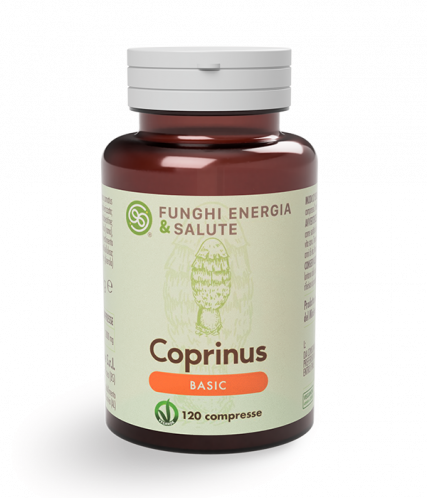Certified Natural products veganOK
030 9881073 Monday to Friday from 09:00 to 17:30


to get immediately a discount code
on your first purchase
Coprinus
- Home
- Coprinus
Scientists have discovered that Coprinus (Coprinus comatus) contains an excellent hypoglycaemic agent, colloidal vanadium, which helps to reduce high levels of blood sugar and glycated hemoglobin, the most important parameter in monitoring blood glucose trends (Bailey et al., 1984; Han et al., 2003 and 2006).
This Medicinal Mushroom, thanks to its ability to nourish lactic acid bacteria, is useful in healing the bacterial flora of the intestine, necessary for the proper functioning of the intestine and its immune response.
In ancient Chinese medicine, Coprinus has always been used for diabetes and for the proper functioning of the intestine.
Mycology
Also called "ink mushroom", Coprinus is a humble mushroom also present in meadows in Europe. In traditional Western folk medicine it is considered beneficial for the reduction of high blood sugar and for the treatment of haemorrhoids.
Its usefulness was first confirmed scientifically in 1934, when some researchers decided to study its properties in depth and discovered the real effectiveness of this Medicinal Mushroom.
Coprinus contains several active ingredients, in particular:
- colloidal vanadium, a very rare mineral that exerts a hypoglycaemic action. Thanks to this peculiarity it is able to reduce glycated hemoglobin and high blood sugar, two important parameters in diabetes. (Bailey et al., 1984; Han et al., 2003 and 2006);
- manganese, which contributes to the control of sugar metabolism;
- vitamin C, rarely found in mushrooms;
- trehalose, a disaccharide composed of two glucose molecules, which is the preferred nutrient of lactic acid bacteria in the intestine. Coprinus, very rich in this prebiotic, improves the bacterial flora of the intestine, which is impaired in many diseases;
- beta-glucans, powerful immunostimulants, including beta-glucans D, 1-6 D, rare in nature (Efremenkova et al., 2001);
- terpenes, powerful immunostimulants capable of increasing immunity and fighting aggressive agents that attack the body (Asatiani et al., 2011; Badalyan and Sisakyan, 2005).
- Asatiani MD, Wasser SP, Nevo E, Ruimi N, Mahajna JA, Reznick A. (2011): “The shaggy ink cap medicinal mushroom, Coprinus comatus (of mull.: fr.) pers.(Agaricomycetideae) substances interfere with h2o2 induction of the Nf-Κb pathway through inhibition of Iκbα phosphorylation in Mcf7 breast cancer cells.” International Journal Of Medicinal Mushrooms, 13(1): 19-25.
- Badalyan S, Sisakyan S. (2005): “Study of antiprotozoal activity and mitogenic effects within some medicinal mushrooms.” International Journal ofMedicinal Mushrooms, 7: 382-383.
- Bailey CJ, Turner SL, Jakeman KJ, Hayes WA. (1984): “Effect of Coprinus comatus on plasma glucose concentrations in mice.” Planta Med., 50 (6): 525-6.
- Efremenkova OV, Ershova EY, Tolstykh IV, Zenkova VA, Dudnik YV. (2001): “The revealing of antimicrobial activity of strains of the genus Coprinus.” Mikol Fitopatol., 35(6): 32-7.
- Han C, Yuan J, Wang Y, Li L. (2006): “Hypoglycemic activity of fermented mushroom of Coprinus comatus rich in vanadium.” J Trace Elem Med Biol., 2006 20(3): 191-6.
- Han C, Xing F, Jiang F, Wang Y. (2003): “A study on co-effects of Coprinus comatus fermentation liquid and sodium vanadate on the process of inhibiting ascension of blood glucose in mice.” Edible Fungi of China, 22 (1): 39-40.
- Lee KA, Lee JS, Yoon JD, Chung MW, Ha, HC, Lee JS. (2005): “Hepatoprotective effects of waxy brown rice cultured with Agrocybe cy- lindracea (DC.) Gillet.” International Journal of Medicinal Mushrooms, 7(3): 351-352.


